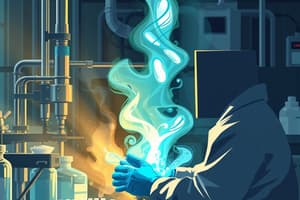Podcast
Questions and Answers
หลักการใดของการปฏิบัติการผลิตที่ดี (GMP) เกี่ยวข้องกับการสร้างระบบบริหารคุณภาพ?
หลักการใดของการปฏิบัติการผลิตที่ดี (GMP) เกี่ยวข้องกับการสร้างระบบบริหารคุณภาพ?
- การควบคุมคุณภาพ (correct)
- การจัดการซัพพลายเออร์
- การจัดการความเสี่ยง
- การบันทึกข้อมูล
บุคลากรใน GMP ต้องมีคุณสมบัติอะไรบ้าง?
บุคลากรใน GMP ต้องมีคุณสมบัติอะไรบ้าง?
- การมีประสบการณ์การทำงานในสนาม
- การทำงานภายใต้ความกดดันได้
- การผ่านการฝึกอบรมและการมีสุขอนามัยที่ดี (correct)
- การเรียนรู้จากเพื่อนร่วมงาน
สิ่งใดถือเป็นส่วนที่สำคัญที่สุดในการควบคุมการผลิตตาม GMP?
สิ่งใดถือเป็นส่วนที่สำคัญที่สุดในการควบคุมการผลิตตาม GMP?
- การตรวจสอบเครื่องจักร
- การปรับปรุงประสิทธิภาพการทำงาน
- การวางแผนการผลิตล่วงหน้า
- การทำให้สภาพแวดล้อมสะอาด (correct)
การจัดการเปลี่ยนแปลงใน GMP ต้องมีการจัดตั้งอะไร?
การจัดการเปลี่ยนแปลงใน GMP ต้องมีการจัดตั้งอะไร?
ใน GMP, การตรวจสอบคุณภาพผลิตภัณฑ์จะต้องทำอย่างไร?
ใน GMP, การตรวจสอบคุณภาพผลิตภัณฑ์จะต้องทำอย่างไร?
ความเสี่ยงที่เกิดขึ้นในกระบวนการผลิต GMP จะถูกจัดการอย่างไร?
ความเสี่ยงที่เกิดขึ้นในกระบวนการผลิต GMP จะถูกจัดการอย่างไร?
การบันทึกข้อมูลใน GMP ควรมีความสำคัญอย่างไร?
การบันทึกข้อมูลใน GMP ควรมีความสำคัญอย่างไร?
หลักการใดของ GMP เน้นระเบียบปฏิบัติที่สอดคล้องกับกฎระเบียบ?
หลักการใดของ GMP เน้นระเบียบปฏิบัติที่สอดคล้องกับกฎระเบียบ?
Flashcards are hidden until you start studying
Study Notes
Principles of Good Manufacturing Practices (GMP)
-
Definition: GMP covers the practices required to ensure that products are consistently produced and controlled according to quality standards.
-
Key Principles:
-
Quality Management:
- Establish a quality management system.
- Ensure products meet quality standards and regulations.
-
Personnel:
- Employ qualified and trained staff.
- Maintain good hygiene and training practices.
-
Premises and Equipment:
- Ensure clean and hygienic manufacturing environments.
- Use suitable equipment that is properly maintained and calibrated.
-
Documentation:
- Maintain comprehensive and accurate records.
- Ensure proper documentation of procedures, processes, and changes.
-
Production Control:
- Implement validated and well-defined manufacturing processes.
- Monitor production processes to prevent errors and contamination.
-
Quality Control:
- Regularly test products to ensure compliance with specifications.
- Implement quality assurance measures throughout the production process.
-
Validation and Qualification:
- Validate processes, equipment, and systems to ensure consistent performance.
- Conduct regular reviews and updates as necessary.
-
Risk Management:
- Identify and mitigate risks in the manufacturing process.
- Implement corrective and preventive actions to address non-conformities.
-
Supplier Quality Assurance:
- Evaluate and manage suppliers to ensure they meet quality standards.
- Maintain quality throughout the supply chain.
-
Change Control:
- Establish procedures for managing changes to processes, equipment, or materials.
- Assess the impact of changes on product quality.
-
-
Regulatory Compliance:
- Follow regulations set by agencies (e.g., FDA, EMA).
- Regularly conduct audits and inspections to ensure compliance.
-
Continuous Improvement:
- Promote a culture of continuous improvement within the organization.
- Use feedback and data to enhance processes and product quality.
แนวทางปฏิบัติในการผลิตที่ดี (GMP)
- ความหมาย: GMP เป็นแนวทางเพื่อให้มั่นใจว่าสินค้าได้รับการผลิตและควบคุมอย่างต่อเนื่องตามมาตรฐานคุณภาพ
- หลักการสำคัญ:
- การจัดการคุณภาพ:
- สร้างระบบการจัดการคุณภาพ
- รับประกันว่าสินค้าปฏิบัติตามมาตรฐานและกฎระเบียบ
- บุคลากร:
- จ้างพนักงานที่ผ่านการฝึกอบรมและมีคุณสมบัติที่เหมาะสม
- รักษามาตรฐานด้านสุขอนามัยและการฝึกอบรม
- สถานที่และอุปกรณ์:
- ทำให้สภาพแวดล้อมการผลิตสะอาดและถูกสุขลักษณะ
- ใช้อุปกรณ์ที่เหมาะสมและได้รับการบำรุงรักษาอย่างถูกต้อง
- เอกสาร:
- รักษาบันทึกที่ครอบคลุมและถูกต้อง
- การจัดทำเอกสารกระบวนการและการเปลี่ยนแปลงอย่างเหมาะสม
- การควบคุมการผลิต:
- ใช้กระบวนการผลิตที่ได้รับการตรวจสอบและจัดแสดงไว้อย่างชัดเจน
- ตรวจสอบกระบวนการผลิตเพื่อป้องกันความผิดพลาดและการปนเปื้อน
- การควบคุมคุณภาพ:
- ทดสอบผลิตภัณฑ์อย่างสม่ำเสมอเพื่อให้แน่ใจว่าปฏิบัติตามข้อกำหนด
- ใช้การประกันคุณภาพตลอดกระบวนการผลิต
- การตรวจสอบและการรับรอง:
- ตรวจสอบกระบวนการ, อุปกรณ์, และระบบเพื่อให้มั่นใจในประสิทธิภาพที่สม่ำเสมอ
- ทำการตรวจสอบและปรับปรุงเป็นประจำตามที่จำเป็น
- การบริหารความเสี่ยง:
- ระบุและบรรเทาความเสี่ยงในกระบวนการผลิต
- ดำเนินการแก้ไขและป้องกันเพื่อจัดการกับความไม่ตรงตามมาตรฐาน
- การประกันคุณภาพของผู้จัดหา:
- ประเมินและจัดการผู้จัดจำหน่ายเพื่อให้มั่นใจว่าปฏิบัติตามมาตรฐานคุณภาพ
- รักษาคุณภาพตลอดห่วงโซ่อุปทาน
- การควบคุมการเปลี่ยนแปลง:
- กำหนดกระบวนการเพื่อจัดการกับการเปลี่ยนแปลงในกระบวนการ, อุปกรณ์, หรือวัสดุ
- ประเมินผลกระทบของการเปลี่ยนแปลงต่อคุณภาพผลิตภัณฑ์
- การจัดการคุณภาพ:
- การปฏิบัติตามกฎระเบียบ:
- ปฏิบัติตามข้อกำหนดที่กำหนดโดยหน่วยงานต่าง ๆ (เช่น FDA, EMA)
- ทำการตรวจสอบและการตรวจสอบอย่างสม่ำเสมอเพื่อให้แน่ใจว่าปฏิบัติตาม
- การปรับปรุงอย่างต่อเนื่อง:
- ส่งเสริมวัฒนธรรมการปรับปรุงอย่างต่อเนื่องภายในองค์กร
- ใช้ข้อเสนอแนะและข้อมูลในการพัฒนากระบวนการและคุณภาพผลิตภัณฑ์
Studying That Suits You
Use AI to generate personalized quizzes and flashcards to suit your learning preferences.




